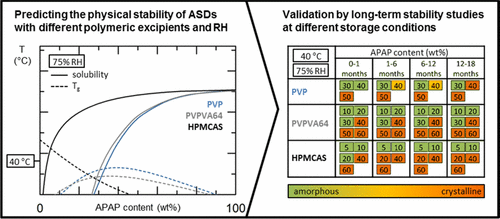当前位置:
X-MOL 学术
›
Mol. Pharmaceutics
›
论文详情
Our official English website, www.x-mol.net, welcomes your
feedback! (Note: you will need to create a separate account there.)
Impact of Polymer Type and Relative Humidity on the Long-Term Physical Stability of Amorphous Solid Dispersions
Molecular Pharmaceutics ( IF 4.5 ) Pub Date : 2017-11-07 00:00:00 , DOI: 10.1021/acs.molpharmaceut.7b00492 Kristin Lehmkemper 1, 2 , Samuel O. Kyeremateng 1 , Oliver Heinzerling 1 , Matthias Degenhardt 1 , Gabriele Sadowski 2
Molecular Pharmaceutics ( IF 4.5 ) Pub Date : 2017-11-07 00:00:00 , DOI: 10.1021/acs.molpharmaceut.7b00492 Kristin Lehmkemper 1, 2 , Samuel O. Kyeremateng 1 , Oliver Heinzerling 1 , Matthias Degenhardt 1 , Gabriele Sadowski 2
Affiliation

|
The purpose of this work is to compare the long-term physical stability of amorphous solid dispersion (ASD) formulations based on three different commercially used excipients, namely, poly(vinylpyrrolidone) K25 (PVP), poly(vinylpyrrolidone-co-vinyl acetate) (PVPVA64), and hydroxypropyl methylcellulose acetate succinate 126G (HPMCAS), at standardized ICH storage conditions, 25 °C/0% relative humidity (RH), 25 °C/60% RH, and 40 °C/75% RH. Acetaminophen (APAP) and naproxen (NAP) were used as active pharmaceutical ingredients (APIs). 18 month long stability studies of these formulations were analyzed and compared with the API/polymer phase diagrams, which were modeled and predicted by applying the Perturbed-Chain Statistical Associating Fluid Theory (PC-SAFT) and the Gordon–Taylor or Kwei equation. The study showed that, at dry storage, the solubility of the APIs in the polymers and the kinetic stabilizing ability of the polymers increase in the following order: HPMCAS < PVPVA64 < PVP. RH significantly reduces the kinetic stabilization as well as NAP solubility in the polymers, while the impact on APAP solubility is small. The impact of RH on the stability increases with increasing hydrophilicity of the pure polymers (HPMCAS < PVPVA64 < PVP). The experimental stability results were in very good agreement with predictions confirming that PC-SAFT and the Kwei equation are suitable predictive tools for determining appropriate ASD compositions and storage conditions to ensure long-term physical stability.
中文翻译:

聚合物类型和相对湿度对非晶态固体分散体长期物理稳定性的影响
这项工作的目的是比较基于三个不同的商业上使用的赋形剂,即,聚(乙烯吡咯烷酮)K25(PVP),聚(vinylpyrrolidone-无定形固体分散体(ASD)制剂的长期物理稳定性的共-醋酸乙烯酯(PVPVA64)和羟丙基甲基纤维素醋酸琥珀酸酯126G(HPMCAS),在标准ICH储存条件,25°C / 0%相对湿度(RH),25°C / 60%RH和40°C / 75的条件下相对湿度 对乙酰氨基酚(APAP)和萘普生(NAP)被用作活性药物成分(API)。分析了这些配方长达18个月的稳定性,并与API /聚合物相图进行了比较,API /聚合物相图通过应用扰动链统计缔合流体理论(PC-SAFT)和Gordon-Taylor或Kwei方程进行建模和预测。研究表明,在干燥储存条件下,API在聚合物中的溶解度和聚合物的动力学稳定能力按以下顺序增加:HPMCAS <PVPVA64 <PVP。RH会显着降低动力学稳定性以及NAP在聚合物中的溶解度,而对APAP溶解度的影响很小。RH对稳定性的影响随纯聚合物亲水性的增加而增加(HPMCAS <PVPVA64 <PVP)。实验稳定性结果与预测非常吻合,证实了PC-SAFT和Kwei方程是确定适当ASD成分和储存条件以确保长期物理稳定性的合适预测工具。
更新日期:2017-11-08
中文翻译:

聚合物类型和相对湿度对非晶态固体分散体长期物理稳定性的影响
这项工作的目的是比较基于三个不同的商业上使用的赋形剂,即,聚(乙烯吡咯烷酮)K25(PVP),聚(vinylpyrrolidone-无定形固体分散体(ASD)制剂的长期物理稳定性的共-醋酸乙烯酯(PVPVA64)和羟丙基甲基纤维素醋酸琥珀酸酯126G(HPMCAS),在标准ICH储存条件,25°C / 0%相对湿度(RH),25°C / 60%RH和40°C / 75的条件下相对湿度 对乙酰氨基酚(APAP)和萘普生(NAP)被用作活性药物成分(API)。分析了这些配方长达18个月的稳定性,并与API /聚合物相图进行了比较,API /聚合物相图通过应用扰动链统计缔合流体理论(PC-SAFT)和Gordon-Taylor或Kwei方程进行建模和预测。研究表明,在干燥储存条件下,API在聚合物中的溶解度和聚合物的动力学稳定能力按以下顺序增加:HPMCAS <PVPVA64 <PVP。RH会显着降低动力学稳定性以及NAP在聚合物中的溶解度,而对APAP溶解度的影响很小。RH对稳定性的影响随纯聚合物亲水性的增加而增加(HPMCAS <PVPVA64 <PVP)。实验稳定性结果与预测非常吻合,证实了PC-SAFT和Kwei方程是确定适当ASD成分和储存条件以确保长期物理稳定性的合适预测工具。











































 京公网安备 11010802027423号
京公网安备 11010802027423号